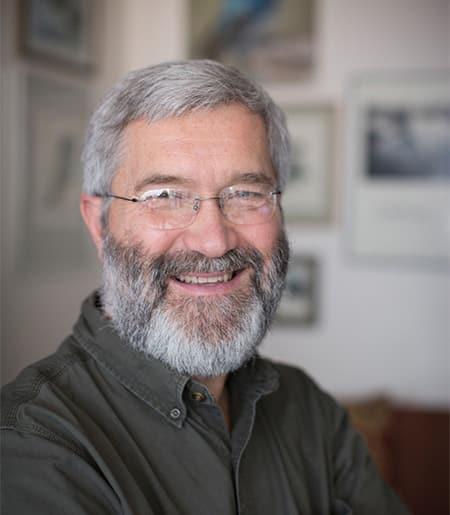Overview
I am an ornithologist with strong interests in physiological, evolutionary and behavioral ecology. My current work explores the causes of temporal and spatial variation in the life histories of birds, focusing mostly on breeding biology and movements. My abiding interest in the Charadriiformes was augmented starting in the mid-1980’s with detailed studies of life history variation in Tree Swallows (Tachycineta bicolor), and then all members of the genus throughout the Americas in a project we call Golondrinas de las Americas. With my students and collaborators, I have been studying everything about these birds that we can on the breeding grounds, from immunocompetence and telomere dynamics to flight performance and the composition of bacterial communities in their nests. We are interested in how changing climates and geographic variation in environments affect all aspects of the life histories of these birds, and in recent years, we are expanding our understanding of their life histories outside the breeding season, with studies of their diets, social behavior and movements. I lead a group of engineers and students that I call TABER (Technology for Animal Biology and Environmental Research), which has recently designed solar-powered radio-tags that are small enough (0.7 g) to place on swallows and can be expected to transmit whenever the sun shines for many years. These tags, and many more like them, are energizing our studies of animal movements, and will fuel our studies for years to come on migration and dispersal. The other area of technological innovation that has sparked my interest of late is the ready availability of high-acuity computed tomography (CT) scanning at Cornell, which has led me to work, with Helen James at the Smithsonian, toward a web site that features a video tour of the anatomy of a member of every family of birds around the world. This brings me back to my undergrad fascination with anatomy and combines it with my career-long dedication to the broadest view of the diversity of life, signified by the recent completion of Bird Families of the World (Lynx Edicions).
I teach a variety of courses at Cornell, including BioEE 4750 Ornithology, BioEE 3610 Advanced Ecology, and BioEE 3780 Computed Tomography of Vertebrates.
Research Focus
Winkler’s lab studies avian life history variation over many scales of space and time. At the most fundamental scale of time, we are interested in how evolution leaves its trace through phylogenetically retained similarities that are molded by current selective pressures. At shorter time scales, we are interested in how annual variations in weather affect the timing of reproduction and migration, and how day-to-day variations in environmental conditions affect foraging success and reproductive performance. At the grandest spatial scales, we study how evolutionary history and biogeographic forces affect the birds that are interacting in different communities around the world. We are challenged to understand how animals guide their journeys all across Earth’s surface, how these routes change and are maintained, and how biotic connections are engendered by these movements. At the finest spatial scales, we are interested in fine-scaled habitat differences and how movements across habitats are guided and informed by information processed and gathered by the dispersing bird. Bringing space and time together, we find the spatio-temporal challenges faced by moving animals both fascinating and distinctively enticing for study with new technological tools.
Publications
- Winkler, D.W., Billerman, S.M., Lovette, I.J. 2015. Bird Families of the World. Barcelona: Lynx Edicions. 599 pages.
- Winkler, D.W., Ringelman, K.M., Dunn, P. O. , Whittingham, L., Hussell, D.J.T., Clark, R.G., Dawson, R.D., Johnson, L.S., Rose, A., Austin, S.H., Robinson, W.D., Lombardo, M.P., Thorpe, P.A., Shutler, D., Robertson, R.J., Stager, M., Leonard, M., Horn, A.G., Dickinson, J., Ferretti, V., Massoni, V., Bulit, F., Reboreda, J.C., Liljesthröm, M., Quiroga, M., Rakhimberdiev, E., & Ardia, D.R. 2014. Latitudinal variation in clutch size-lay date regressions in Tachycinetaswallows: effects of food supply or demography? Ecography 37:001-009 doi: 10.1111/j. 1600-0587.2013.00458.x
- Winkler, D.W., Jørgensen, C., Both, C., Houston, A.I., McNamara, J.M., Levey, D.J., Partecke, J., Fudickar, A., Kacelnik, A., Roshier, D. and Piersma, T. 2014. Cues, strategies, and outcomes: how migrating vertebrates track environmental change. Movement Ecology, 2(10).
- Winkler, D.W., Luo, M.K., & Rakhimberdiev, E. 2013. Temperature effects on food supply and chick mortality in tree swallows (Tachycineta bicolor). Oecologia 173(1):129-138.
- Gumus, A., S. Lee, S.S. Ahsan, K. Karlsson, R. Gabrielson, C.G. Guglielmo, D.W. Winkler, and D. Erickson. 2015. Lab-on-a-Bird: Biophysical Monitoring of Flying Birds. PLoS One. e0123947.
- Shafer, M.W., R. MacCurdy, J.R. Shipley, D. Winkler, C.G. Guglielmo, and E. Garcia. 2015. The case for energy harvesting on wildlife in flight. Smart Materials and Structures 24(2):025031.
- Rakhimberdiev, E., Winkler, D. W., Bridge, E., Seavy, N. E., Sheldon, D., Piersma, T., & Saveliev, A. 2015. A hidden Markov model for reconstructing animal paths from solar geolocation loggers using templates for light intensity. Movement ecology, 3(1), 1-15.
- Winkler, D.W., F.A. Gandoy, J.I. Areta, M.J. Iliff, E. Rakhimberdiev, K.J. Kardynal, K.A. Hobson. 2017. Long-Distance Range Expansion and Rapid Adjustment of Migration in a Newly Established Population of Barn Swallows Breeding in Argentina. Current Biology 27(7):1080-1084. DOI: 10.1016/j.cub.2017.03.006
- Lisovski, S., H. Schmaljohann, E.S. Bridge, S. Bauer, A. Farnsworth, S.A. Gauthreaux Jr., S. Hahn, M.T. Hallworth, C.M. Hewson, J.F. Kelly, F. Liechti, P.P. Marra, E. Rakhimberdiev, J.D. Ross, N.E. Seavy, M.D. Sumner, C.M. Taylor, D.W. Winkler, S.J. Wotherspoon, M.B. Wunder. 2017. Inherent limits of light-level geolocation may lead to over-interpretation. Current Biology 28(2):R99-R100. DOI: 10.1016/j.cub.2017.11.072
- Twining, C.W., J.T. Brenna, P. Lawrence, J.R. Shipley, T.N. Tollefson, and D.W. Winkler. Omega-3 long-chain polyunsaturated fatty acids support aerial insectivore performance more than food quantity. 2017. Proceedings of the National Academy of Sciences; published ahead of print September 16, 2016 DOI: 10.1073/pnas.1603998113

